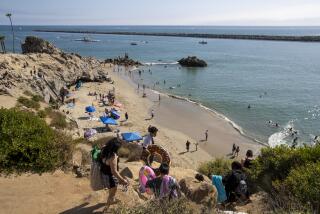Walks on the Arm of the Coast
- Share via
It’s as east as the East Coast gets. Cape Cod thrusts farther out into the Atlantic Ocean than any other part of America. “A man may stand there and put all America behind him,” wrote Henry David Thoreau in his classic book “Cape Cod,” published in 1865.
Even today, some Cape Cod places, during certain seasons, allow coast walkers to put most of America--or at least the cape’s summer resort traffic and commercial strips--well behind them. For the hiker, the world’s largest glacial peninsula is a grand assemblage of ponds, pine barrens, beaches, dunes and marshes.
“Cape Cod” not only shows the marvelous nature writer in fine form, but shows his uncanny ability to look into the future. Thoreau regarded the then-empty beaches and predicted: “The time must come when this coast will be a place of resort for those New Englanders who really wish to visit the seaside.”
About 5 million visitors a year flock to Cape Cod’s shores. Cape Cod is within a day’s drive of 75 million Americans, so it’s no surprise that it’s the most visited of America’s 10 national seashores.
Best seasons for walking Cape Cod are during its short spring and its long, lingering autumn. You won’t find much fall color on Cape Cod; the attractions are crisp air, clear skies and deserted beaches.
Cape Cod’s history is as long as that of America. In 1620, the Pilgrims landed the Mayflower on the cape at what is now known as Provincetown. They explored Cape Cod for a month before making a second, more famous landing at Plymouth.
Cape Cod, named for the bounty of that fish found in the bay, might have also been named Cape Clam for the multitude of that mollusk or Cape Cranberry for the nation’s first cranberry bogs. In 1873, a railroad line reached the Cape, and in later years a road was built down the center of the Cape. With transportation came tourist traffic, lots of it.
By the late 1950s, many year-round residents, prominent part-timers and East Coast conservationists realized that Cape Cod was falling victim to its own popularity and implored the National Park Service to preserve a portion of the it. Not surprisingly, President Kennedy, whose family had long enjoyed the cape, strongly supported its preservation, and signed legislation establishing Cape Cod National Seashore in 1961.
At 43,556 acres, Cape Cod National Seashore is small by national park standards; nevertheless, it’s the largest national park area in New England. With the exception of Provincetown, most of the tip of the cape is included within the borders of the national seashore.
Cape Cod is often described as “the bended elbow of Massachusetts.” The National Seashore includes the stretch of Atlantic shore from where the elbow of the arm bends northward up to, and around, the fist to Cape Cod Bay. This 40 miles of shoreline is known as “The Great Beach.”
For the walker there is much to explore. Best bets for beach-walking are the dozen or so Atlantic-facing beaches, including Nauset, Coast Guard, Marconi, Cahoon Hollow and Race Point. High tides, strong currents and storms sculpt the Lower Cape, shaping that quintessential Cape Cod landform--Outer Beach’s sea cliffs. Sand dunes are piled high--fun for children of all ages.
Along with lots of beach to roam, the national seashore has 11 short nature trails. Start with mile-long wetland-exploring Nauset Marsh Trail, which begins at the Salt Pond Visitor Center.
Atlantic White Cedar Swamp Trail (1.25 miles) tours a stunted oak and pine forest, then leads along a boardwalk through the swamp. Cranberry Bog Trail (1.5 miles) meanders through several abandoned cranberry operations.
The best and longest trail within the national seashore is the 5.5-mile round-trip Great Island Trail, which travels the heights of Great Island on the bay side of the cape. The trail tours a pitch pine forest, the site of a Colonial-era tavern and a salt marsh. At low tide, the intrepid walker can continue to Jeremy Point along a 1.5-mile-long sandy trail that dangles south from the main body of Great Island.
Well-prepared, Thoreau-loving hikers sometimes retrace part of the great naturalist’s classic walk up Cape Cod. The pilgrimage of choice is usually a 30-mile jaunt from Chatham to Provincetown. Of course, most walkers don’t rough it like Thoreau, preferring instead to walk with only a day pack and stay the night at inns in different towns along the way. Carry a paperback copy of “Cape Cod” on this great American walk, and enjoy both a rhapsodic book and beachcombing.
(BEGIN TEXT OF INFOBOX / INFOGRAPHIC)
Great Island Trail
WHERE: Cape Cod National Seashore.
DISTANCE: Short nature trails 1- to 5-miles round trip; “Thoreau Walk” is 30 miles one way.
TERRAIN: Pine forest, wetlands, dunes, beach.
HIGHLIGHTS: East Coast beauty, New England-style beach culture.
DEGREE OF DIFFICULTY: Easy to moderate.
PRECAUTIONS: Time beach walks for low tide.
FOR MORE INFORMATION: Cape Cod National Seashore, South Wellfleet, MA 02663; tel. (508) 349-3785. Also the Cape Cod Chamber of Commerce; tel. (508) 362-3325.
More to Read
Sign up for The Wild
We’ll help you find the best places to hike, bike and run, as well as the perfect silent spots for meditation and yoga.
You may occasionally receive promotional content from the Los Angeles Times.






